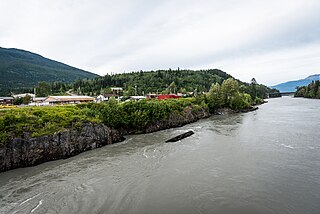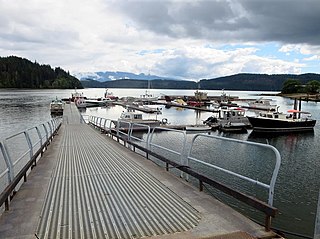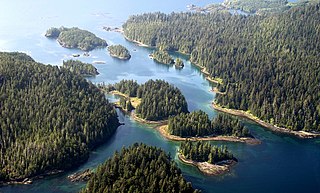
Burrard Inlet is a relatively shallow-sided fjord in northwestern Lower Mainland, British Columbia, Canada. Formed during the last Ice Age, it separates the City of Vancouver and the rest of the lowland Burrard Peninsula to the south from the coastal slopes of the North Shore Mountains, which span West Vancouver and the City and District of North Vancouver to the north.

Portland Canal is an arm of Portland Inlet, one of the principal inlets of the British Columbia Coast. It is approximately 114 km (71 mi) long. The Portland Canal forms part of the border between southeastern Alaska and British Columbia. The name of the entire inlet in the Nisga'a language is Kʼalii Xkʼalaan, with xkʼalaan meaning "at the back of (someplace)". The upper end of the inlet was home to the Tsetsaut, who after being decimated by war and disease were taken under the protection of the Laxsgiik (Eagle) chief of the Nisga'a, who holds the inlet's title in native law.

The Nass River is a river in northern British Columbia, Canada. It flows 380 km (240 mi) from the Coast Mountains southwest to Nass Bay, a sidewater of Portland Inlet, which connects to the North Pacific Ocean via the Dixon Entrance. Nass Bay joins Portland Inlet just south of Observatory Inlet.
Anyox was a small company-owned mining town in British Columbia, Canada. Today it is a ghost town, abandoned and largely destroyed. It is located on the shores of Granby Bay in coastal Observatory Inlet, about 60 kilometres southeast of Stewart, British Columbia, and about 20 kilometres, across wilderness east of the tip of the Alaska Panhandle.

Jervis Inlet is one of the principal inlets of the British Columbia Coast, about 95 km (59 mi) northwest of Vancouver, and the third of such inlets north of the 49th parallel, the first of which is Burrard Inlet, Vancouver's harbour.
Seymour Inlet is one of the lesser travelled of the principal inlets of the British Columbia Coast. Unlike larger inlets such as Knight or Bute, it is not flanked by mountains but by relatively low, but still rugged, coastal hill-country and forms a maze of complex, narrow waterways and tidal pools and lagoons. It is located within a corresponding maze of peninsulas on the mainland on the northwest side of the Queen Charlotte Strait region.
Dean Channel is the upper end of one of the longest inlets of the British Columbia Coast, 105 km (65.2 mi) from its head at the mouth of the Kimsquit River. The Dean River, one of the main rivers of the Coast Mountains, enters Dean Channel about 9.5 km (5.9 mi) below the head of the inlet, at the community of Kimsquit.
Nisga'a Highway, officially designated British Columbia Highway 113, is a highway in the Regional District of Kitimat-Stikine in British Columbia. It starts in Terrace at Highway 16. The route provides paved access to the settlements of the Nisga'a Nation - Gitlaxt'aamiks, Gitwinksihlkw, Gingolx (Kincolith), Laxgalts'ap (Greenville), Nass Camp and others. It enters the Nass Country via the valley of Kitsumkalum Lake, which connects from the Skeena and via the Nisga'a Lava Beds Provincial Park. The route heads north from Terrace and once into the Nass River Valley then travels west to Gingolx (Kincolith) for a total of 169 kilometres (105 mi). There is a 12-kilometre (7.5 mi) spur between New Aiyansh and Nass Camp.

Robert Tomlinson (1842–1913) was an Irish Anglican medical missionary, known for his work with the indigenous peoples of British Columbia.

Ging̱olx is a Nisg̱a’a Village in the Nass River valley in British Columbia, Canada. The village population is approximately 400 people. Ging̱olx is one of four Nisg̱a’a villages that make up the Nisg̱a’a Nation. The community itself has four clans which are Killer Whale, Eagle, Raven and Wolf. Ging̱olx village's government consists of 1 chief and 5 councillors.

Portland Inlet is an inlet of the Pacific Ocean on the north coast of British Columbia, Canada, approximately 55 km (34 mi) north of Prince Rupert. It joins Chatham Sound opposite the Dixon Entrance. It is 4 km (2.5 mi) long and as much as 13 km (8.1 mi) wide. It drains the Portland Canal, Nass Bay, and Khutzeymateen Inlet, among others, and is the site of Pearse Island and Somerville Island. Other major sidewaters of the inlet are Observatory Inlet and its east arm, Alice Arm.
South Bentinck Arm is a 40 km (25 mi) long side-inlet of Dean Channel in the Central Coast region of British Columbia, Canada. At the north end of the arm it meets the North Bentinck Arm and then the Dean Channel before flowing into the Burke Channel.

Quatsino Sound is a complex of coastal inlets, bays and islands on northwestern Vancouver Island in the Canadian province of British Columbia. It is the northernmost of the five sounds that pierce the west coast of Vancouver Island, the others being Kyuquot Sound, Nootka Sound, Clayoquot Sound, and Barkley Sound.
Observatory Inlet is an inlet on the North Coast of British Columbia. It is a northward extension of Portland Inlet, other branches of which include the Portland Canal. The entrance of Observatory Inlet, from Portland Inlet, lies between Ramsden Point and Nass Point. Ramsden Point also marks, to the west, the entrance of Portland Canal. Observatory Inlet was named by George Vancouver in 1793, because he set up his observatory on the shore of the inlet, at Salmon Cove, in order to calibrate his chronometers. His two vessels, HMS Discovery and HMS Chatham, stayed in Salmon Cove from July 23 to August 17, 1793. During this time a boat surveying expedition under Vancouver himself explored Behm Canal. Vancouver also named three headlands at the entrance of Observatory Inlet: Maskelyne Point, for Nevil Maskelyne, the Astronomer Royal, Wales Point, for William Wales, the mathematical master who sailed with James Cook, and Ramsden Point, after the famed mathematical instrument-maker Jesse Ramsden.
Alice Arm is a locality, former post office, and steamer landing on the North Coast of British Columbia, Canada, located on the east side of Observatory Inlet at the mouth of the Kitsault River. There are still a number of houses standing and several seasonal homeowners who still access their houses every year. It was the location of a short rail line that accessed the mine.
Kitsault also known as Chandra Krishnan Kitsault is an unincorporated settlement and a private town on the North Coast of British Columbia, Canada, at the head of Alice Arm, Observatory Inlet and at the mouth of the Kitsault River. The locality of Alice Arm and the Nisga'a community of Gits'oohl are in the immediate vicinity. "Kitsault" is an adaptation of Gits'oohl, which means "a ways in behind".
The Kitsault River is a river on the North Coast of British Columbia, Canada, located at the head of Alice Arm, which is the east arm of Observatory Inlet, which is itself an arm of Portland Inlet. Located at the mouth of the river are the localities of Alice Arm, Kitsault and Gits'oohl, a community of the Nisga'a people which was the Gitzault Indian Reserve No. 24 prior to the Nisga'a Treaty.
Hastings Arm is a fjord on the North Coast of British Columbia, which is the northwest arm of Observatory Inlet, one of the two main branchings of Portland Inlet, the other being the better-known Portland Canal, which forms part of the Canada–United States border. Hastings Arm is approximately 30 km (19 mi) in length from the divergence of Observatory Inlet near the former smelting town of Anyox, where a 25 km (16 mi) east arm, Alice Arm, branches off towards its head at the mouth of the Kitsault River. This divergence is approximately 50 km (31 mi) from the mouth of Observatory Inlet itself, near Nass Bay, which is the outer part of the estuary of the Nass River. At the head of Hastings Arm is the mouth of the Kshwan River, and the Nisga'a village-site of Kswan.

Salmon Inlet, formerly Salmon Arm, is a fjord branching east from Sechelt Inlet in the British Columbia, Canada. Its companion, Narrows Inlet, another side-inlet of Sechelt Inlet, lies roughly 10 km (6.2 mi) north. Misery and Sechelt Creeks flow freely into the inlet, while the Clowhom River flows in from the artificial Clowhom Lake, formed by a small hydroelectric power development. The fjord is 23 km (14 mi) long; Clowhom Lake, covering a waterfall on the Clowhom River, stretches a further 12 km (7.5 mi) to the western base of Mount Tantalus, which is best known from the direction of Squamish and the Cheakamus Canyon stretch of British Columbia Highway 99. Heavily affected by logging and milling operations, the inlet is split almost into two portions by an alluvial fan spreading from the mouth of Sechelt Creek.

Checleset Bay is a bay on the northwest coast of Vancouver Island, British Columbia, Canada. It is located southeast of Brooks Peninsula and northwest of Kyuquot Sound. Much of the land around the bay is part of Brooks Peninsula Provincial Park. Checleset Bay has three large inlets, Nasparti Inlet, Ououkinsh Inlet, and Malksope Inlet.










